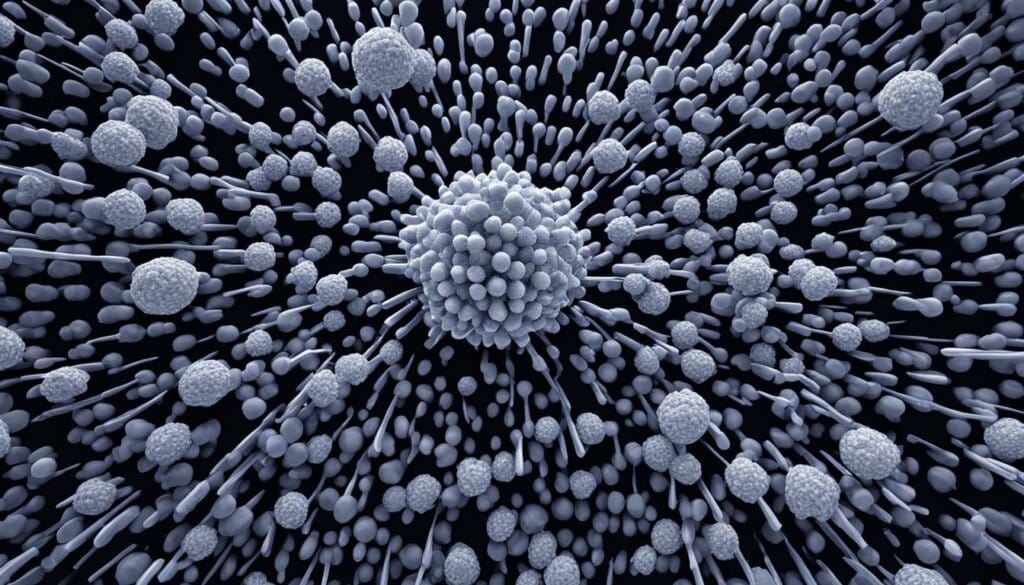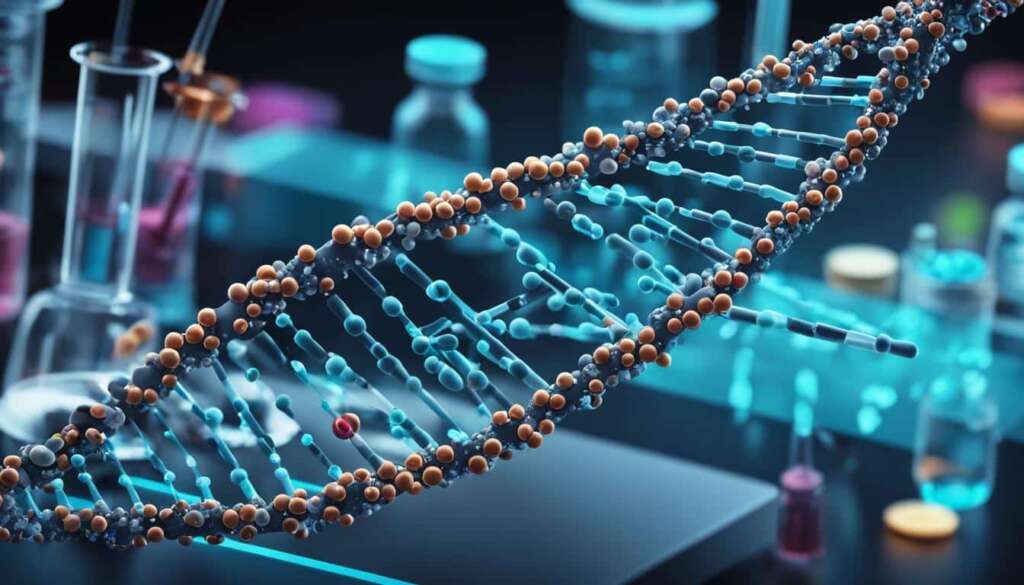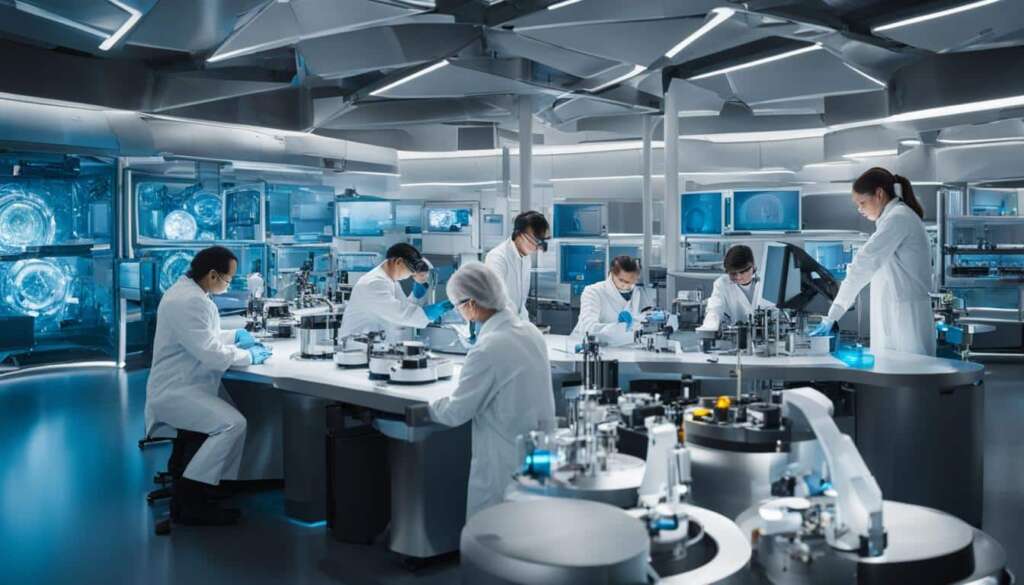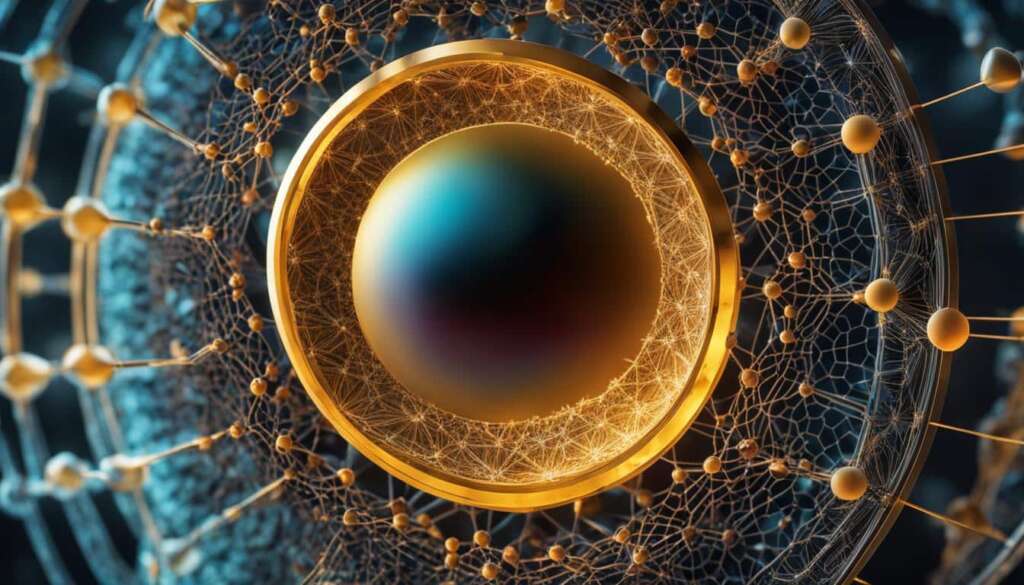Table of Contents
Silver nanotechnology is revolutionizing various industries, including healthcare and industry, with its wide range of applications and numerous advantages. It offers innovative solutions and promising results in diverse fields, such as medicine, food, cosmetics, pharmaceuticals, and more. The use of silver nanoparticles (AgNPs) provides unique physical and chemical properties, high surface area, and versatile functionality, making it a valuable tool in different industries.
Key Takeaways
- Silver nanotechnology has widespread applications in healthcare and industry.
- It offers unique physical and chemical properties, providing versatile functionality.
- Silver nanoparticles have promising results in medicine, food, cosmetics, and pharmaceuticals.
- The use of silver nanotechnology can revolutionize various industries, improving efficiency and outcomes.
- Continued research and development are essential to ensure the safe and ethical use of nanotechnology.
The Role of Nanofertilizers in Agriculture
Nanofertilizers have emerged as a novel approach in agriculture for sustainable crop production and plant development. These nanoscale fertilizers offer several benefits that contribute to the overall sustainability of agricultural practices.
- Enhanced nutrient uptake: Nanofertilizers enable plants to efficiently absorb essential nutrients, leading to improved crop yield and quality.
- Increased crop yield: The precise delivery of nutrients through nanofertilizers promotes healthy plant growth, resulting in higher crop productivity.
- Improved soil conditions: Nanofertilizers have the ability to enhance soil fertility, structure, and nutrient retention, creating a favorable environment for plant development.
Research has shown that the use of nanofertilizers has the potential to revolutionize the agricultural industry by addressing critical challenges such as nutrient availability, nutrient losses, and environmental stresses. These innovative fertilizers can significantly enhance nutrient uptake efficiency and reduce the negative environmental impact of excessive fertilizer use. In addition, nanofertilizers improve plant resilience to various environmental stresses, including drought, salinity, and disease.
Nanofertilizers work by leveraging nanotechnology to encapsulate and deliver essential nutrients directly to the plants in a controlled and targeted manner. This targeted delivery ensures that the plants receive the right amount of nutrients when and where they need them the most, optimizing their growth and development. Furthermore, the nanoscale size and unique properties of these fertilizers enable them to penetrate the plant tissues more efficiently, resulting in improved nutrient absorption.
“Nanofertilizers offer a sustainable solution to enhance crop production while minimizing environmental impact.” – Dr. Emma Davies, Agricultural Research Scientist
The table below illustrates the benefits of nanofertilizers for sustainable crop production and plant development:
| Benefits of Nanofertilizers | |
|---|---|
| Enhanced nutrient uptake | Increased crop yield |
| Improved soil conditions |
The Future of Nanofertilizers
The use of nanofertilizers in agriculture is still a relatively new field of research. However, the promising results and potential benefits have sparked interest among scientists, farmers, and policymakers. As further advancements in nanotechnology and agricultural sciences are made, nanofertilizers are expected to play a significant role in sustainable crop production and food security.
The utilization of nanofertilizers has the potential to minimize the environmental impact of conventional fertilizers, enhance nutrient use efficiency, reduce fertilizer wastage, and ultimately contribute to the development of a more sustainable and environmentally-friendly agricultural sector.
Nanoparticles for Environmental Remediation
Nanoparticles have shown great potential in environmental remediation, particularly in the treatment of pollutants and contaminants in water. They can effectively remove heavy metals, organic pollutants, and other harmful substances from water sources through adsorption, catalysis, and degradation processes. Nanoparticles offer high surface area, reactivity, and selectivity, making them efficient and sustainable options for water treatment and environmental cleanup.
Key Benefits of Nanoparticles in Environmental Remediation:
- Effective removal of pollutants and contaminants
- Adsorption, catalysis, and degradation processes
- High surface area, reactivity, and selectivity
- Efficient and sustainable water treatment
Nanoparticles play a crucial role in addressing water pollution and improving the quality of water resources. Their unique properties enable them to interact with various pollutants and facilitate their removal from the environment. By utilizing nanoparticles in environmental remediation, we can achieve cleaner and safer water for both human and ecological health.
“Nanoparticles have proven to be versatile and efficient in removing pollutants from water, offering a sustainable solution for environmental remediation.” – Dr. Emily Johnson, Environmental Scientist
One of the most common applications of nanoparticles in water treatment is the removal of heavy metals, such as lead, mercury, and arsenic. These toxic metals pose significant risks to both human and environmental health. By utilizing nanoparticles, we can effectively trap and remove these pollutants, preventing their harmful effects.

| Pollutants | Nanoparticle technology |
|---|---|
| Heavy metals (lead, mercury, arsenic) | Functionalized nanoparticles for adsorption and ion exchange |
| Organic pollutants (pesticides, pharmaceuticals) | Nanocatalysts for degradation and oxidation |
| Microplastics | Nanoparticles for filtration and removal |
Nanoparticles can also play a crucial role in the treatment of organic pollutants, including pesticides and pharmaceuticals. Through nanocatalytic processes, these contaminants can be degraded into non-toxic byproducts, reducing their impact on the environment.
Furthermore, nanoparticles can be utilized in the filtration and removal of microplastics, a growing concern in water pollution. By incorporating nanoparticles into filtration systems, we can effectively capture and remove microplastics, preventing their entry into the ecosystem.
Overall, nanoparticles offer an innovative and sustainable approach to environmental remediation, specifically in water treatment. Their unique properties and versatile functionality make them valuable tools in the fight against water pollution and the preservation of our precious water resources.
Silver Nanoparticles in Biomedical Applications
Silver nanoparticles have garnered significant attention in the field of biomedical applications due to their exceptional antimicrobial properties, biocompatibility, and unique physicochemical characteristics. These nanoparticles hold immense potential in improving healthcare outcomes and combating various infectious diseases.
One of the key advantages of silver nanoparticles in biomedical applications is their antimicrobial activity. They have been extensively studied for their ability to inhibit the growth of bacteria, viruses, and fungi. The small size of silver nanoparticles allows them to penetrate the cell walls of these microorganisms, disrupting their vital functions and preventing their proliferation. This makes silver nanoparticles highly effective in preventing and treating infections.
“Silver nanoparticles exhibit excellent antimicrobial activity, making them a promising tool for combating infectious diseases in the healthcare industry.”
In addition to their antimicrobial properties, silver nanoparticles offer versatility in various biomedical applications. They can be incorporated into wound dressings and bandages to promote quicker and more effective wound healing. The unique physicochemical properties of silver nanoparticles enable them to interact with cells and stimulate tissue regeneration, leading to accelerated wound closure and reduced risk of infection.
Furthermore, silver nanoparticles can be utilized in the development of antibacterial coatings for medical devices and implants. These coatings help to prevent bacterial colonization and biofilm formation, reducing the risk of device-related infections. The incorporation of silver nanoparticles into medical device materials enhances their antimicrobial properties without compromising biocompatibility.
Another promising area of biomedical research involving silver nanoparticles is drug delivery. The small size and high surface area of these nanoparticles enable efficient loading and controlled release of therapeutic agents. This opens up new possibilities for targeted drug delivery, where medications can be selectively delivered to specific tissues or cells, minimizing side effects and improving treatment efficacy.
Moreover, silver nanoparticles play a crucial role in the development of diagnostic tools. They can be functionalized with specific biomolecules or antibodies to target disease markers or antigens, enabling sensitive detection and diagnosis of various medical conditions. This offers potential advancements in early disease detection and personalized medicine.
“The unique properties of silver nanoparticles make them ideal for wound healing, antibacterial coatings, drug delivery systems, and diagnostic tools in biomedical applications.”
Overall, silver nanoparticles have demonstrated significant potential in biomedical applications, presenting opportunities for innovative solutions and improved healthcare outcomes. Their versatile nature, antimicrobial properties, and biocompatibility make them invaluable tools in various fields, ranging from wound care to drug delivery and disease diagnosis.
Nanotechnology for Targeted Cancer Therapy
Nanotechnology has revolutionized cancer therapy, providing a breakthrough in targeted drug delivery systems using nanoparticles. These nanoparticles, when functionalized with specific ligands or antibodies, can selectively target cancer cells and deliver drugs directly to the tumor site. This targeted approach significantly minimizes damage to healthy tissues while improving the efficacy of cancer treatments.
By leveraging nanotechnology, researchers have been able to enhance the precision and effectiveness of cancer therapies. The use of nanoparticles allows for controlled drug release, ensuring that the medication reaches its intended target. This targeted drug delivery approach also reduces the potential side effects associated with conventional chemotherapy, thus enhancing patient outcomes.
Nanoparticles have unique physical and chemical properties that make them ideal candidates for drug delivery systems. They can be engineered to carry different types of drugs, including chemotherapy drugs and immunotherapeutics. Additionally, the size and surface properties of nanoparticles can be tailored to improve their biocompatibility, biodistribution, and cellular uptake.
The utilization of nanotechnology for targeted cancer therapy is a promising avenue in the fight against cancer. It offers potential solutions to the challenges associated with conventional treatments, such as systemic toxicity and drug resistance.
Nanotechnology holds great promise for personalized and precision medicine, enabling healthcare providers to tailor treatments to individual patients. The ability to deliver therapeutic agents directly to cancer cells while sparing healthy tissues opens up new possibilities for improved treatment outcomes and reduced side effects.
Advantages of Nanoparticle-based Cancer Therapy:
- Enhanced targeting of cancer cells
- Reduced damage to healthy tissues
- Improved efficacy of cancer treatments
- Minimized side effects
- Potential for combination therapy
An illustration below showcases the targeted drug delivery using nanoparticles in cancer therapy:

Applications of Nanotechnology in Food Safety
Nanotechnology offers innovative solutions for ensuring food safety through various applications. It can be used in food packaging to enhance barrier properties, extend shelf life, and prevent contamination. Nanosensors and nanodevices enable rapid and sensitive detection of pathogens, toxins, and contaminants in food. Nanoparticles can also be employed for food preservation, improving the efficiency of antimicrobial treatments and reducing microbial growth. Nanotechnology plays a crucial role in enhancing food safety and quality.
Applications of Nanotechnology in Food Safety
Nanotechnology has demonstrated vast potential in ensuring the safety and quality of our food. By leveraging the unique properties of nanoparticles, scientists and researchers have developed solutions that address various challenges in the food industry.
“Nanotechnology offers an exciting avenue for enhancing food safety through innovative applications.”
Enhancing Food Packaging
One key application of nanotechnology in ensuring food safety is through advanced packaging. Nanomaterials can be incorporated into packaging films and coatings to enhance their barrier properties, preventing the transfer of gases, moisture, and contaminants. These nanocomposite materials provide an additional layer of protection, extending the shelf life of perishable food products.
For example, clay nanoparticles can be added to polymer films to create a barrier against oxygen, preventing spoilage and preserving food freshness. Similarly, silver nanoparticles have antimicrobial properties that inhibit the growth of bacteria and fungi, minimizing the risk of contamination.
Rapid Detection of Pathogens and Contaminants
Nanotechnology also enables the development of rapid and sensitive detection systems for pathogens, toxins, and contaminants in food. Nanosensors and nanodevices can be designed to specifically recognize and respond to particular substances, providing real-time monitoring and analysis.
These nanosensors can detect even trace amounts of harmful substances, enabling early identification and intervention to prevent foodborne illnesses. By reducing testing time and improving accuracy, nanotechnology contributes to enhanced food safety standards.
Efficient Food Preservation
In addition to packaging and detection, nanotechnology plays a crucial role in food preservation. Antimicrobial treatments using nanoparticles have shown significant potential in inhibiting microbial growth and prolonging the shelf life of food products.
For instance, silver nanoparticles have been incorporated into food packaging materials and coatings to release antimicrobial agents gradually, providing long-lasting protection against bacteria and fungi. Similarly, nanoencapsulation techniques can be employed to develop delivery systems for natural antimicrobial compounds, ensuring their controlled release and efficacy.
Nanotechnology and Future Innovations
The use of nanotechnology in food safety continues to evolve, with ongoing research and development efforts focusing on new applications and improved techniques. Future innovations may include nanostructured antimicrobial films, nanosensors embedded in smart packaging, and nanomaterials for targeted delivery of bioactive compounds.
As nanotechnology advances, it will undoubtedly contribute to the development of safer and more sustainable approaches in the food industry, ensuring that consumers can enjoy food that is both delicious and free from potential risks.
Nanotechnology in Energy and Environmental Sustainability
Nanotechnology is playing a vital role in advancing energy and environmental sustainability. Through its innovative applications, nanotechnology has the potential to address some of the pressing issues facing our planet, including the development of more efficient and cost-effective renewable energy sources.
One of the key areas where nanotechnology is making a significant impact is in the field of energy generation. By harnessing the unique properties of nanomaterials, researchers have been able to develop highly efficient solar cells and fuel cells. These nanomaterials enhance energy storage, conversion, and utilization processes, leading to improved efficiency and reduced environmental impact. This breakthrough technology holds great promise for a future powered by clean, renewable energy.
Beyond energy generation, nanotechnology also offers solutions for environmental monitoring, pollution prevention, and remediation. Nanosensors can detect and monitor environmental pollutants with high sensitivity and accuracy, enabling actions to be taken swiftly to mitigate their impact. Additionally, nanomaterials can be used to develop efficient systems for the removal and remediation of pollutants in air, water, and soil.
Advancements in Renewable Energy
One of the most significant contributions of nanotechnology to energy sustainability is its role in improving the efficiency of renewable energy sources. Solar cells, for example, have benefitted greatly from nanotechnology advancements. Nanostructured materials, such as quantum dots and nanowires, have shown enhanced light absorption capabilities, allowing for greater efficiency in capturing solar energy. These advancements have made solar energy more accessible and cost-effective, paving the way for widespread adoption across the globe.
Nanotechnology has revolutionized the development of efficient renewable energy sources, contributing to a more sustainable future.
Nanotechnology is also playing a critical role in the development of fuel cells. By utilizing nanomaterials as catalysts, fuel cells can efficiently convert chemical energy into electrical energy with minimal waste. This has the potential to revolutionize the transportation sector, as fuel cell-powered vehicles offer a clean and sustainable alternative to traditional fossil fuel-powered vehicles.
Environmental Monitoring and Remediation
In addition to advancements in renewable energy, nanotechnology is instrumental in environmental monitoring and remediation. Nanosensors, capable of detecting even trace amounts of pollutants, allow for real-time monitoring of air and water quality. This enables prompt action to mitigate pollution levels and ensure a healthier environment for all.
Nanomaterials also have the ability to remove pollutants from air, water, and soil through various processes such as adsorption and catalysis. By leveraging the unique properties of nanoparticles, such as their high surface area and reactivity, contaminants can be efficiently captured and transformed into less harmful substances. This technology shows great potential in addressing the environmental challenges we face and achieving a more sustainable future.
Overall, nanotechnology is a powerful tool in advancing energy and environmental sustainability. Its applications in renewable energy, environmental monitoring, and pollution remediation are driving positive change toward a greener and more sustainable future for all.

The Role of Nanotechnology in Sustainable Energy
The role of nanotechnology in sustainable energy goes beyond improving the efficiency of renewable energy sources. Nanomaterials offer opportunities for energy storage, improved battery performance, and enhanced catalytic processes. By fine-tuning the structure and properties of nanomaterials, scientists can develop materials with high-energy density and long-term stability, enabling the widespread adoption of renewable energy technologies.
| Nanotechnology Advancements | Applications |
|---|---|
| Nanostructured materials for solar energy conversion | Efficient solar cells, solar panels |
| Nanocatalysts for fuel cell optimization | Clean and efficient fuel cell technology |
| Nanomaterials for energy storage | High-capacity batteries, supercapacitors |
| Nanoscale interfaces for improved energy conversion | Enhanced energy generation and utilization |
These advancements in nanotechnology contribute to the overall efficiency and sustainability of renewable energy systems, reducing the reliance on non-renewable energy sources and minimizing the environmental impact of energy generation.
Environmental Sustainability and Pollution Prevention
In addition to its role in energy, nanotechnology offers solutions for environmental sustainability and pollution prevention. Nanomaterials have been used in various applications to reduce pollution, improve resource efficiency, and promote a cleaner environment.
One notable example is the application of nanomaterials in water treatment. Nanoparticles can be utilized for the removal of pollutants, including heavy metals and organic compounds, from water sources. Their high surface area and unique reactivity make them effective adsorbents and catalysts for water purification. This technology holds great potential for addressing water pollution issues and ensuring access to clean and safe drinking water.
Nanotechnology also plays a role in waste management and recycling. The development of nanomaterials for efficient separation and recovery of valuable resources from waste streams can contribute to a circular economy and reduce the reliance on raw materials. Additionally, nanomaterial-based sensors and monitoring systems offer improved detection and control of environmental pollutants, enabling proactive measures for pollution prevention and control.
Innovation for a Sustainable Future
The potential of nanotechnology in energy and environmental sustainability is vast. By continuing to invest in research and development, we can unlock new advancements and applications that will drive the transition to a more sustainable future. From renewable energy generation to pollution prevention and resource efficiency, nanotechnology offers innovative solutions that can contribute to a greener and more sustainable planet.
“Nanotechnology is paving the way for a sustainable future by addressing challenges in energy and the environment.”
Ethical and Safety Considerations in Nanotechnology
As nanotechnology continues to advance and find applications in various industries, ethical and safety considerations become crucial. It is essential to address potential risks associated with nanoparticles, including their long-term effects on human health and the environment. Regulations and risk assessment protocols need to be established to ensure the safe and responsible use of nanotechnology. Ethical considerations regarding privacy, informed consent, and equitable access to nanotechnology should also be addressed in the development and deployment of nanomaterials.
The Risks of Nanoparticles
When considering the use of nanotechnology, understanding the risks and potential hazards is of utmost importance. Nanoparticles have unique properties that can pose challenges when it comes to safety. Their small size and large surface area-to-volume ratio may result in increased reactivity and potential toxicity.
“The properties of nanomaterials, including nanoparticles, can lead to potential risks to human health and the environment.”
Studies have shown that certain nanoparticles can penetrate biological barriers, such as the blood-brain barrier, and accumulate in tissues, raising concerns about their long-term effects. It is crucial to conduct thorough risk assessments to identify potential hazards and develop appropriate safety measures.
Regulations and Risk Assessment
To ensure the safe and responsible use of nanotechnology, regulations and risk assessment protocols must be established. Governments and regulatory bodies play a vital role in setting standards and guidelines for the development, production, and use of nanomaterials.
The regulatory framework should encompass various aspects, including product safety, labeling requirements, disposal guidelines, and worker protection. Risk assessment protocols should evaluate the potential hazards associated with nanomaterials and establish exposure limits and control measures.
Ethical Considerations
In addition to safety regulations, ethical considerations are paramount in the development and deployment of nanotechnology. Privacy concerns arise with the use of nanosensors and nanodevices that collect and transmit personal data. It is necessary to ensure the protection of individuals’ information in nanotechnology applications.
Informed consent should also be a fundamental ethical principle in research and development involving nanomaterials. Individuals should have a clear understanding of the potential risks and benefits associated with nanotechnology and have the right to make informed decisions regarding their participation.
Equitable access to nanotechnology is another crucial ethical consideration. It is essential to bridge the gap between developed and developing countries, ensuring that the benefits of nanotechnology are distributed fairly and contribute to sustainable development globally.
Conclusion
In conclusion, silver nanotechnology offers significant benefits across diverse sectors, including healthcare, industry, and agriculture. The unique properties of silver nanoparticles present numerous opportunities for innovation and improvement in various applications. From medicine to food and environmental remediation, silver nanotechnology has the potential to revolutionize industries.
However, it is crucial to continue investing in research and development to further understand the potential risks associated with silver nanotechnology. This will ensure its safe and ethical use in different fields. By establishing robust regulations and risk assessment protocols, we can responsibly harness the benefits of silver nanotechnology.
The future prospects of silver nanotechnology are highly promising. Its continued advancements hold the potential for revolutionizing industries, creating sustainable solutions, and addressing global challenges. With ongoing research and responsible implementation, silver nanotechnology will play a crucial role in shaping a more efficient and sustainable future.
FAQ
What industries can benefit from silver nanotechnology?
Silver nanotechnology has applications in various industries, including healthcare, industry, agriculture, and more. Its unique properties make it a valuable tool in medicine, food, cosmetics, pharmaceuticals, and other sectors.
How can nanofertilizers contribute to sustainable agriculture?
Nanofertilizers offer enhanced nutrient uptake, increased crop yield, and improved soil conditions. They have the potential to significantly enhance nutrient availability, reduce nutrient losses, and improve plant growth and resilience to environmental stresses, thus contributing to sustainable crop production and plant development.
What role can nanoparticles play in environmental remediation?
Nanoparticles can effectively remove pollutants and contaminants in water through adsorption, catalysis, and degradation processes. They have high surface area, reactivity, and selectivity, making them efficient and sustainable options for water treatment and environmental cleanup.
How are silver nanoparticles used in biomedical applications?
Silver nanoparticles possess antimicrobial properties, biocompatibility, and unique physicochemical characteristics, making them suitable for wound healing, antibacterial coatings, drug delivery systems, and diagnostic tools. They show great potential in improving healthcare outcomes and combating infectious diseases.
In what way does nanotechnology contribute to targeted cancer therapy?
Nanotechnology enables targeted drug delivery systems using nanoparticles, which can be functionalized to selectively target cancer cells. This approach delivers drugs directly to the tumor site while minimizing damage to healthy tissues, improving the efficacy of cancer treatments, reducing side effects, and enhancing patient outcomes.
How can nanotechnology ensure food safety?
Nanotechnology offers innovative solutions in food packaging to enhance barrier properties, extend shelf life, and prevent contamination. Nanosensors and nanodevices enable rapid and sensitive detection of pathogens, toxins, and contaminants in food. Nanoparticles can also be used for food preservation, improving antimicrobial treatments and reducing microbial growth to enhance food safety and quality.
How does nanotechnology contribute to energy and environmental sustainability?
Nanotechnology enables the development of more efficient and cost-effective renewable energy sources, such as solar cells and fuel cells. Nanomaterials enhance energy storage, conversion, and utilization processes, improving efficiency and reducing environmental impact. Nanotechnology also offers solutions for environmental monitoring, pollution prevention, and remediation.
What ethical and safety considerations should be addressed in nanotechnology?
It is essential to address potential risks associated with nanoparticles, including their long-term effects on human health and the environment. Regulations and risk assessment protocols need to be established to ensure the safe and responsible use of nanotechnology. Ethical considerations regarding privacy, informed consent, and equitable access to nanotechnology should also be addressed in its development and deployment.













